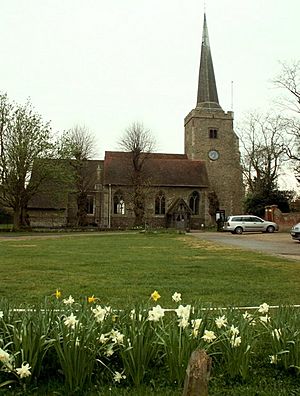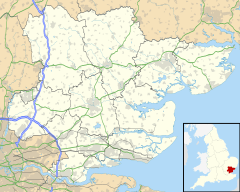Danbury, Essex facts for kids
Quick facts for kids Danbury |
|
|---|---|
 St John the Baptist church |
|
| Population | 6,500 |
| OS grid reference | TL783050 |
| District | |
| Shire county | |
| Region | |
| Country | England |
| Sovereign state | United Kingdom |
| Post town | Chelmsford |
| Postcode district | CM3 |
| Dialling code | 01245 |
| Police | Essex |
| Fire | Essex |
| Ambulance | East of England |
| EU Parliament | East of England |
| UK Parliament |
|
Danbury is a village in Essex, a county in England. It's part of the City of Chelmsford area. Danbury is about 33.5 miles (54 km) northeast of London. Around 6,500 people live here. The village sits on a hill that is 367 feet (112 meters) above sea level.
Did you know that Danbury, Connecticut in the United States is named after this very village?
Contents
A Look at Danbury's Past
Early Beginnings
Danbury was built on the site of an old hill fort. A hill fort is a type of fort built on a hill, used for protection. This one was made by people from the Neolithic or early Iron Age. It has an interesting oval shape.
According to a local plan from 2003, different groups of people lived in the Danbury area over time. First, there were Iron Age settlers. Then came the Romans. Finally, a Saxon tribe called the Dæningas settled there.
The name 'Danbury' was first written down in the Domesday Book in 1086. The Domesday Book was a huge survey of England ordered by William the Conqueror. The name 'Danbury' means 'the fort of Dene's people'. This is also where the name for the village and peninsula of Dengie in Essex comes from.
After the Norman Conquest in 1066, King William the Conqueror took control of the land. He then gave it to Geoffrey de Mandeville, who became the first Earl of Essex.
From Medieval Times to the Georgian Era

In the Middle Ages, Danbury grew from two main areas called manors: St Cleres/Herons and Runsell. You can still find parts of these old areas today. The oldest building in the village is the church of St John the Baptist. It was built in the 13th century and is a very important historical building.
There's a local story that the church's tall spire was damaged by the Devil in 1402. The legend says the Devil looked like a monk and left by passing between a man's legs. The man later got sick and died.
The village has a long history with the Sinclair family, also known as St Clere. Inside the church, you can see three wooden statues from the 13th and 14th centuries. One of these is believed to be William St Clere. In 1968, this statue was even shown at the Louvre museum in Paris, France!
In 1808, a famous writer named Sir Walter Scott visited Danbury. He stayed at the Griffin Inn. He was trying to finish a book called Queenhoo Hall, which was a romantic story.
The Victorian Period
By the early 1800s, the church needed a lot of repairs. A big restoration project started in 1866. A famous architect named George Gilbert Scott worked on it. The church was closed for over a year. After the work, it could hold more people. Some of the wooden pews (church benches) are still from medieval times! Many of them have special carvings called "poppy heads."
The church also has memorial stones for the Mildmay family. Sir Walter Mildmay founded Emmanuel College, Cambridge, which is a college at a famous university. He also built a large house called Danbury Place in 1589. The original house is gone, but a new one was built in 1832 in a style that looked like old Tudor buildings.
This new house was bought by the Church of England in 1845. It became the home for the Bishop of Rochester and was known as Danbury Palace until 1892. Later, it was a private home and even a maternity hospital during World War II. Now, it has been turned into apartments.
The mansion is located within Danbury Country Park. This park used to be a place where deer were kept in medieval times. Later, more gardens were added in the 18th and 19th centuries. Today, Essex County Council owns the park. It is used for outdoor activities for young people by Essex Outdoors.
Danbury Today
Danbury is surrounded by lots of woods and open land. Much of this land is owned by the National Trust and other groups that protect nature. Danbury Common is a special area south of the village. It is a Site of Special Scientific Interest, meaning it has important plants, animals, or geology.
Even though the countryside around Danbury is quiet, a busy road, the A414 road, runs right through the village center. This road connects Danbury to Maldon in the east and Chelmsford in the west. Several bus services connect Danbury to nearby towns and villages.
Danbury has its own community magazine called The Focus. It's also delivered to the nearby villages of Bicknacre and Little Baddow.
Education
Danbury has several primary schools for younger children. These include Danbury Park Community Primary School, St. John's Church of England Primary School, Heathcote Preparatory School, and Elm Green Preparatory School. However, there are no secondary schools (high schools) in Danbury itself.
International Friends
Danbury has a "twin town" in France. This means they have a special friendship and cultural exchange.
 Croissy-sur-Seine, Ile-de-France, France
Croissy-sur-Seine, Ile-de-France, France
Famous People from Danbury
Many interesting people have connections to Danbury:
- Peter Ashdown (born 1934), a former car racing driver.
- Cecil Armstrong Gibbs (1889–1960), an English composer who wrote music.
- Graham Harvey (born 1944), a British sports shooter.
- Neil Innes (1944–2019), an English writer, comedian, and musician.
- Jeremy Lloyd (1930–2014), an English writer, screenwriter, and actor.
- Phil Powers (born 1978), an English professional wrestler.
- The famous composer Ralph Vaughan Williams wrote his music piece Sancta Civitas in Danbury in 1923.
Nearby Places to Explore
- Woodham Walter
- Bicknacre
- East Hanningfield
- Great Baddow
- Little Baddow
- Maldon
- Sandon
- South Woodham Ferrers
See also
 In Spanish: Danbury (Essex) para niños
In Spanish: Danbury (Essex) para niños


